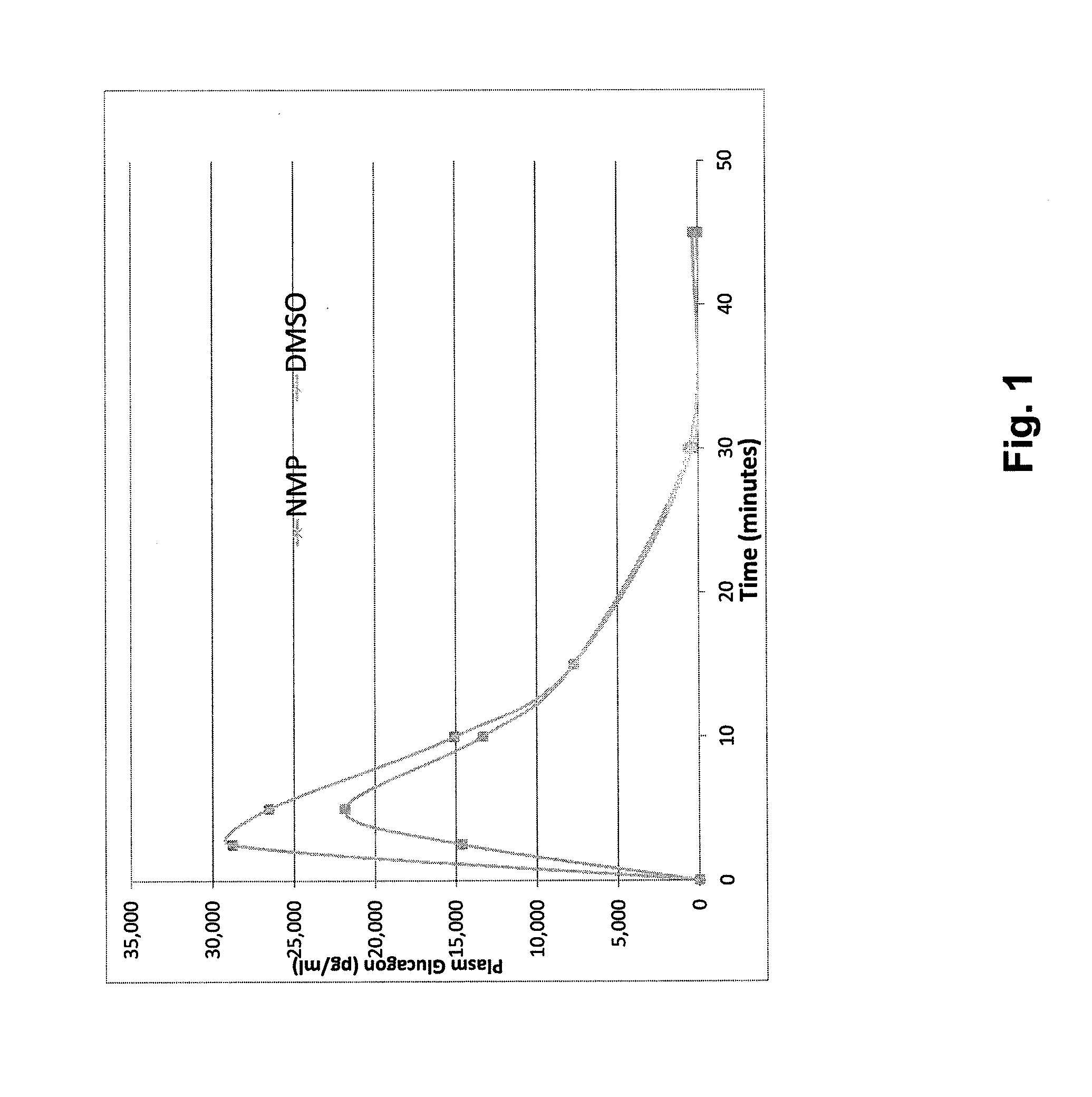Stable formulations for parenteral injection of peptide drugs
a technology of peptides and formulations, applied in the field of pharmaceutical formulations, can solve the problems of reducing the incidence of diabetes, reducing the risk of side effects, and reducing the safety of patients, and achieve the effect of simple administration
- Summary
- Abstract
- Description
- Claims
- Application Information
AI Technical Summary
Benefits of technology
Problems solved by technology
Method used
Image
Examples
example 1
Preparation of Glucagon Solutions for Use in Freeze-Drying
[0127]Various solutions were prepared to contain glucagon at a concentration of 10 mg / mL. The solutions contained, alternatively, glycine, citrate or phosphate at 5 mM, generally providing a buffer establishing a pH of 3. The solution also contained a sugar, alone or in combination, in amounts equal to the w / v amount of glucagon (1:1) or at 200% (2:1) of the amount of glucagon. The sugars were trehalose, HES, and β-cyclodextrin (β-CD). Some solutions also contained Tween-20 at 0.10% w / v as a surfactant. The various formulations were mixed to substantial homogeneity in amounts as described in Table 1 below.
TABLE 1Glucagon Mixtures for Subsequent LyophilizationGlycineCitratePhosphateFormulationGlucagonBufferBufferBufferTrehaloseHESβ-CDTween-20#(mg / ml)(mM)(mM)(mM)(mg / ml)(mg / ml)(mg / ml)(mg / ml)155000000255000000.01355001000045500010005550055006550000100750500000850500000.0195050100001050500100011505055001250500010013500500001450050...
example 2
Preparation of Dry Glucagon Powder by Freeze-Drying
[0129]The above formulations of Table 1 were pipetted (0.3 mL) into 3-mL lyophilization vials (13-mm ID). The formulations were lyophilized in a FTS Durastop freeze-drier (Stoneridge, N.Y.). Samples were frozen at −40° C. at a ramp of 2.5° C. / min and maintained for 2 hours (h) to allow sufficient freezing. The sample temperature was then increased to −5° C. at a ramp of 2° C. / min and held for 2 h as an annealing step. The temperature was then decreased to 30° C. at a ramp of 1.5° C. / min and the vacuum was turned on at 60 mTorr. The primary drying was set for 24 h. The temperature was gradually increased to 40° C. at a ramp of 0.5° C. / min and held for additional 10 h. After drying was complete, the vials were capped under vacuum using XX stoppers from the West Pharmaceutical company (product #10123524). None of the formulations showed any evidence of cake collapse following freeze-drying. The moisture content of the final dried produ...
example 3
Preparation of Glucagon Formulations in Aprotic Polar Solvents
[0130]Six of the dry powders made from the solutions in Table 1 were selected for formulation in polar, aprotic solvents:[0131]1. Buffer (glycine)+trehalose (200% relative to glucagon) (formulation #3)[0132]2. Buffer (glycine)+HES (200% relative to glucagon) (formulation #4)[0133]3. Buffer (glycine)+trehalose (100% relative to glucagon)+HES (100% relative to glucagon) (formulation #5)[0134]4. Buffer (glycine)+Tween-20 (0.01% w / v)+trehalose (200% relative to glucagon) (formulation #19)[0135]5. Buffer (glycine)+Tween-20 (0.01% w / v)+HES (200% relative to glucagon) (formulation #20)[0136]6. Buffer (glycine)+Tween-20 (0.01% w / v)+trehalose (100% relative to glucagon)+HES (100% relative to glucagon) (formulation #21)
PUM
| Property | Measurement | Unit |
|---|---|---|
| temperatures | aaaaa | aaaaa |
| temperatures | aaaaa | aaaaa |
| freezing point | aaaaa | aaaaa |
Abstract
Description
Claims
Application Information
 Login to View More
Login to View More - R&D
- Intellectual Property
- Life Sciences
- Materials
- Tech Scout
- Unparalleled Data Quality
- Higher Quality Content
- 60% Fewer Hallucinations
Browse by: Latest US Patents, China's latest patents, Technical Efficacy Thesaurus, Application Domain, Technology Topic, Popular Technical Reports.
© 2025 PatSnap. All rights reserved.Legal|Privacy policy|Modern Slavery Act Transparency Statement|Sitemap|About US| Contact US: help@patsnap.com


